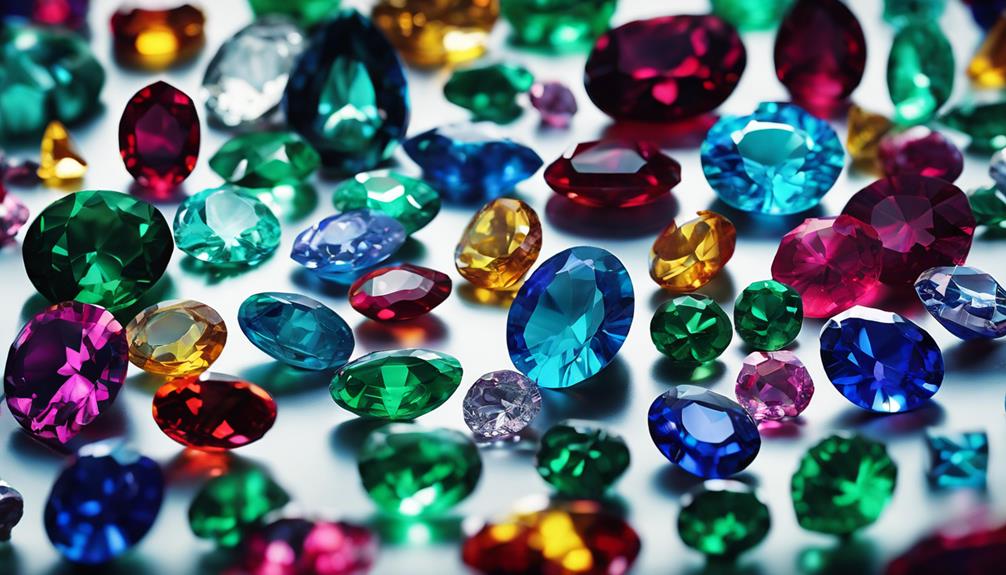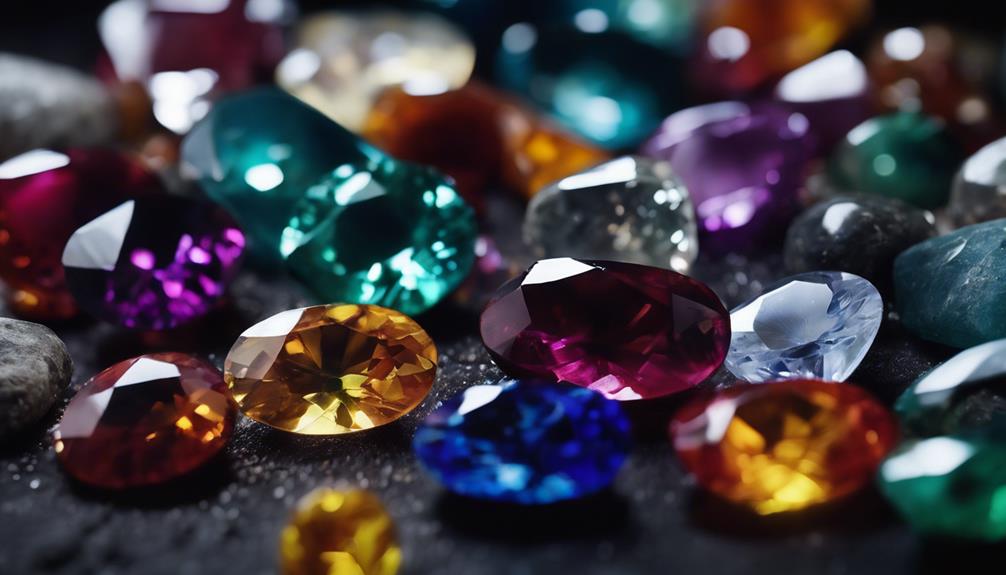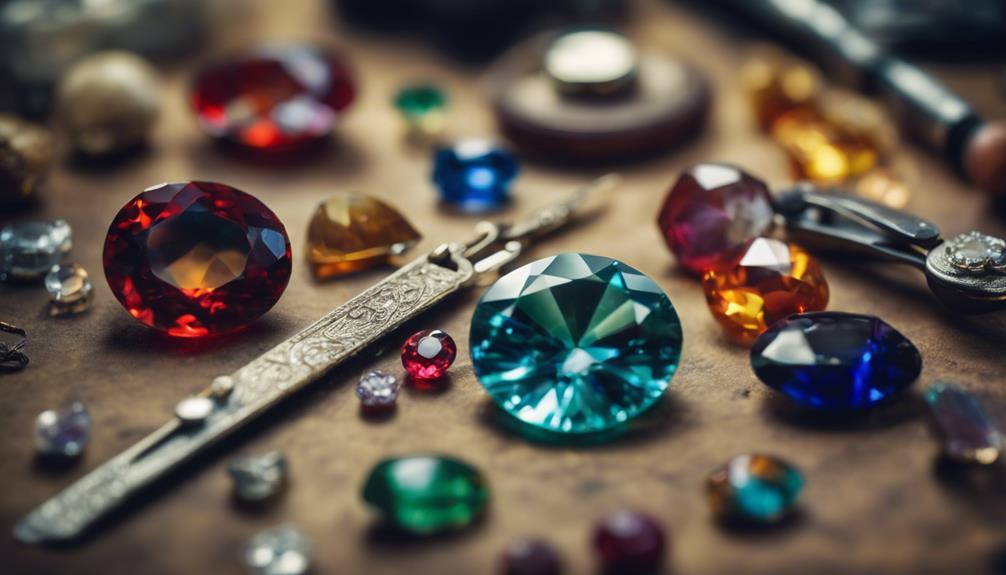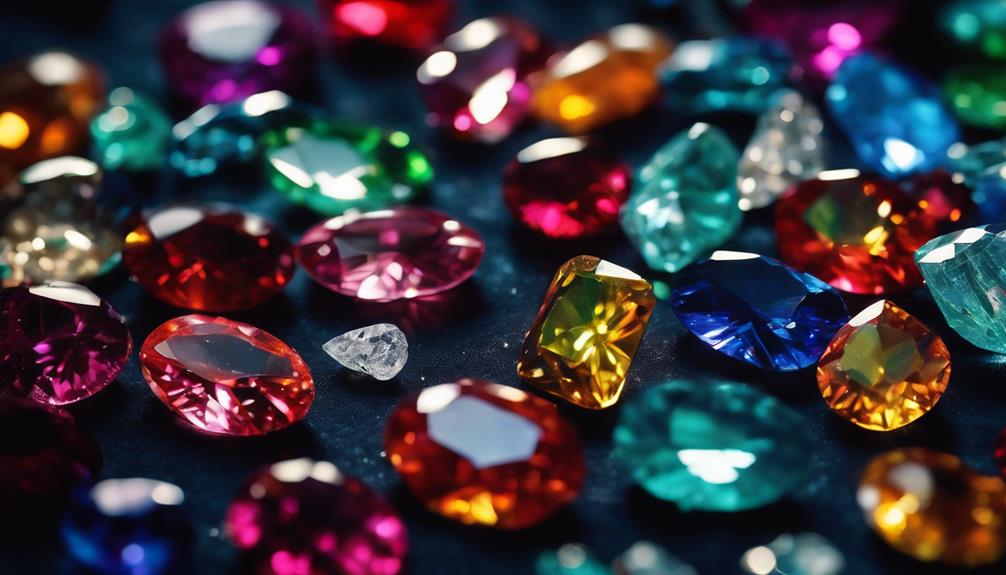When it comes to gemstones, you’ll find they’re not only beautiful but also rich in history and meaning. They’re classified into precious stones like diamonds and emeralds, and semi-precious stones like amethyst and garnet. Each gemstone is unique, with distinct characteristics such as hardness, color, and symbolic powers. For instance, sapphire symbolizes wisdom while emerald represents longevity. Rarity and quality of color greatly influence their value. To make informed purchases, focus on color and buy from reputable sellers. Ready to uncover more fascinating details about gemstones? Keep going.
Definition and Classification

Gemstones, defined as jewels made from mineral crystals cut and polished for adornment, are classified into precious and semi-precious stones, each with unique characteristics. Precious stones include diamonds, rubies, sapphires, and emeralds. These gems are typically rarer and more valuable due to their exceptional hardness, color, and clarity. Semi-precious stones, such as amethyst, garnet, and peridot, while beautiful, are generally more abundant and less costly.
You’ll find that gemstones fall into three main categories: mineral, organic, and rock. Mineral gemstones are inorganic crystals like sapphires and emeralds. Organic gemstones, like pearls and opals, form from biological processes. Rock gemstones, such as lapis lazuli, are aggregates of multiple minerals.
When classifying gemstones, focus on factors like chemical composition, crystal system, hardness, translucency, and color quality. The Mohs scale measures hardness, with diamonds scoring a perfect 10, rubies and sapphires at 9, and softer stones like pearls and opals scoring lower.
Understanding these classifications helps you appreciate the diversity and uniqueness of each gemstone, allowing you to make informed choices whether you’re buying jewelry or simply admiring their beauty.
Symbolism and Meaning
Throughout history, people have believed gemstones possess unique powers and symbolic meanings that go beyond their physical beauty. You might be surprised to learn that many cultures attribute healing, protective, and even magical properties to these glittering stones.
For instance, alexandrite is thought to bring love and good luck, changing its color from purplish-red to green depending on the light. If you’re seeking peace and strength, amethyst, with its spectrum from pinkish lilac to deep violet, could be the stone for you.
Aquamarine, named for its serene blue-green hue, is believed to promote tranquility and healing, making it a popular choice for those looking to soothe their minds. Bloodstone, green with red spots, has been associated with health and liveliness for centuries. Citrine, ranging from light yellow to brownish orange, symbolizes serenity and new beginnings.
If you’re into birthstones, each month has a special gemstone with its own historical references and symbolic meanings. These stones, often mentioned in ancient texts like the Bible, are said to bring good fortune to those born in their respective months.
Characteristics and Properties

When choosing a gemstone, you’ll notice each one has distinct characteristics that make it unique. For instance, Morganite is known for its soft pink color and healing properties for the heart and mind. Its hues can even include subtle purples and oranges.
On the other hand, Opal stands out with its kaleidoscope of colors, considered a symbol of good luck.
Gemstones are valued based on several factors. Rarity plays a vital role; rarer stones naturally command higher prices. The quality of color also considerably impacts a gemstone’s value. Richer, more vibrant colors tend to be more desirable and expensive.
Market demand can fluctuate, affecting values over time. Additionally, cultural significance can add layers of value to certain gemstones, often driving up their market prices.
Investing in gemstones can be financially rewarding. Rarity and high demand contribute to appreciating values, making some gemstones attractive investment assets. Citrine, for example, is less expensive but known for its warm, inviting colors, making it a popular choice.
Understanding these unique properties and valuation factors guarantees that you make informed decisions whether you’re buying for beauty, investment, or both.
Popular Gemstones
You’ll find that certain gemstones are consistently favored for their beauty and symbolic meanings in jewelry.
Diamonds, for instance, symbolize strength and wealth and are prized for their unmatched hardness and sparkle.
Emeralds, with their vibrant green hues, signify longevity and truth, making them a timeless choice for many.
Garnets, resembling rich red pomegranate seeds, are believed to bring power and good fortune. They’re an affordable yet stunning option for various types of jewelry.
Moissanite, almost indistinguishable from diamonds, symbolizes luck and love, offering a budget-friendly alternative with excellent brilliance.
Moonstones, known for their unique glow and multi-colored appearance, are associated with wisdom and fertility. These stones add a mystical touch to any piece of jewelry.
Sapphires, typically blue but found in various colors, symbolize wisdom and royalty, making them a versatile and cherished choice.
Amethysts, ranging from pinkish lilac to deep violet, are valued for their strength and peaceful energy.
Finally, opals, with their kaleidoscope of colors, are believed to bring good luck and are often used to create eye-catching, vibrant jewelry pieces.
These popular gemstones provide a range of options to suit different tastes and meanings, making them perennial favorites in the world of jewelry.
Buying and Valuation Tips

Selecting the perfect gemstone for your jewelry involves focusing on key buying and valuation tips to guarantee you get the best value and quality.
First, prioritize color. Striking colors often hold more value than cut, clarity, or carat weight. Rich, vibrant hues can make a gemstone stand out and considerably increase its worth.
Next, make sure you buy from reputable vendors. Companies like James Allen and Leibish & Co. are known for their high-quality images and trustworthy reputations. This helps in making informed decisions and prevents potential scams.
Be aware of treatments that gemstones might undergo. Some enhancements can affect both quality and price. Untreated stones are generally more valuable, so always ask for a treatment report.
Don’t be overly concerned about minor inclusions. They’re common and can add character to the stone without drastically affecting its value.
Consulting with an expert can provide valuable insights into color and valuation. Professionals can guide you through the complexities of gemstone purchasing, ensuring you make a wise investment.
Conclusion
Now that you’ve explored the world of gemstones, you’re equipped with the knowledge to appreciate and assess these stunning treasures.
Remember, whether it’s understanding their symbolism, recognizing their unique properties, or making informed purchases, you’ve got the basics covered.
So go ahead, explore, collect, and maybe even invest in these enchanting gems.
Your journey into this glittering landscape is just beginning, and the dazzling possibilities are endless.
Happy gem hunting!



